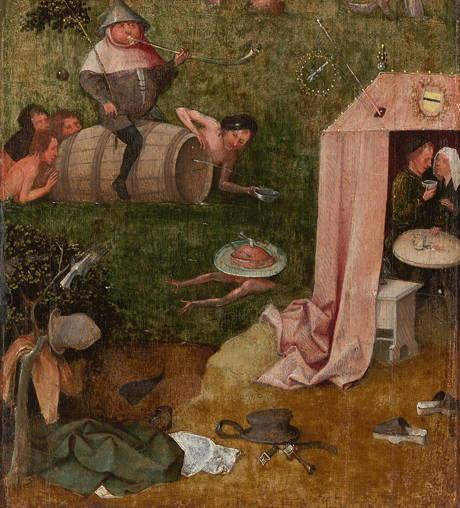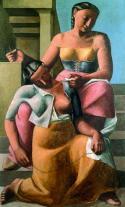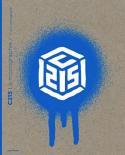Art Of The Day Weekly
#418 - from 18 February 2016 to 24 February 2016

Jheronimus Bosch, Glutony (fragment of the Ship of Fools), ca. 1500-10, New Haven (USA), Yale University Art Gallery. Photo Rik Klein Gotink and image processing Robert G. Erdmann for the Bosch Research and Conservation Project
IN THE AIR
Bosch, the exhibit of the year
BOIS-LE-DUC (Pays-Bas) – In order to celebrate in a dignified manner its most famous native son,– a painter of the end of the Middle Ages– when it doesn’t own a single of his paintings, the city came up with a brilliant idea. It showed a scientific project capable of convincing major international museums to lend their treasures. And it did not even offer a future exchange as is done traditionally. That is more or less the procedure Jerome Bosch’s native city followed to organise the exhibition to honour the 500th anniversary of his death. An ambitious investigation based on the most recent techniques in radiology, spectrography and dendrochronology helped scan all of his works of art, to study the hidden details –as well as the regrets-and to steer the restorations. Bosch is very rare: indeed, he only produced 24 paintings on wood panel and 20 drawings. But that is practically a carton full for the organizers, who have 17 paintings and 19 drawings! When one measures the frailness and the value of these works one appreciates the success of the project. The Tentation de saint Antoine stayed in Lisbon, but the Nef des fous from Louvre, the Allégorie de la débauche from Yale and even the Jugement dernier from Bruges all made the journey. There was a last minute disappointment, from the Prado museum. The authorities were shocked by the allocation of two of its master pieces -the Pierre de folie and its own Tentation de saint Antoine- to the artist’s workshop and not to the artist himself. So they refused at the last minute to lend them. Though they did allow the Chariot de foin to travel and to return to the Netherlands 450 years after it left.
•
• Jheronimus Bosch – Visions of Genius at the Noordbrabants Museum, from 13 February to 8 May 2016.
• The website of the Bosch Research and Conservation Project
MUSEUMS
An attempt to render the hell of Verdun
VERDUN – The apocalypse hit the Meuse on 21 February 1916: German canons shot one million shells in 24 hours. The apocalypse lasted ten months, until 18 December. Three hundred days and 1 000 deaths per day, i.e. 300 000 dead, 60 million shells, i.e. one per square meter in a land that is forever devastated. How can the ‘end-of-the-world’ battle be told, how can the horror of these cold figures be understood? After two and a half years of refurbishment works the Mémorial de Verdun has completely renovated its museography. The function of what had first been designed at opening in 1967 as a place of contemplation for the French victims in the heart of the “red zone”, untouched since the end of the war, has evolved. Unexpected donations of objects such as letters and drawing notebooks, uniforms, fragments of tainted glass, gloves and gas masks, wooden legs and many more, and the taking into account the German point of view have turned the project into a real multinational centre of memory. It is also a permanent warning for the future: when one walks in the midst of the 75 mm shells and rolling kitchens, between the last words uttered by painter Frans Marc - who died on 4 March 1916- and the orders to execute certain soldiers ‘to set an example’, through this mud that has been perfectly recreated where so many men died of gangrene, one is convinced that war is a true stupidity. We also realize that Europe which so many criticise endlessly, has preserved us all from it for nearly 75 years. Among the objects that move the visitor there is the trunk of Louis Pergaud, the author of the wonderful children’s – and adults’- novel, la Guerre des boutons. It had been sent back to his widow. It included a pair of socks, a few cigarettes, a scarf, a pencil. The last souvenirs of a man among others, who would have preferred to continue fighting with marbles and slingshots.
• Le Mémorial de Verdun (55100 Fleury-devant-Douaumont) will open again to the public on 22 February 2016.
EXHIBITIONS
Investigation on Piero
FORLÌ – He is one of the best-known painters of the Italian Renaissance and yet one of the most enigmatic. Piero della Francesca (1420-1492), the author of the cycle on the Leggenda della Vera Croce(Legend of the real cross) at Arezzo, created his own universe, one that was very formal, with a geometric and symmetric architecture, with strict perspectives, a universe in which men looked like silent models, carriers of a disquieting strangeness. Hence the impact his work had in the XXth century, at a time of research into the self, onto psyche, into alienation. After replacing Piero in his time with his masters and disciples, the main objective of the exhibition is his influence through the centuries. His work was rediscovered through Charles Loyeux, the author of remarkable XIXth century copies, then by the Bloomsbury group with Duncan Grant and finally by Roberto Longhi. One can then follow a whole vein in the XXth century that was inspired by his light, by his hieratic style, the feeling of absence: Balthus, of course, as well as talented Italian group with Felice Casorati, Massimo Campigli, Corrado Cagli.
• Piero. Indagine su un mito at the Musei San Domenico, from 13 February to 26 June 2016.
ELSEWHERE IN EUROPE
Modern Bacchantes
BORDEAUX – The figure of the Bacchante, a creature of Bacchus, can be seen throughout ancient art. Modern artists have also been influenced as can be seen in this exhibition at the Galerie des beaux-arts that combines, among others, Géricault, Gérôme and Bakst. From 12 February to 23 May 2016.
The Vivarini, a family affair
CONEGLIANO – Three Venetian painters over two generations: Antonio, Bartolomeo and Alvise, at the head of their bottega, contributed in the second half of the XVth century to the passage from Gothic art to the Renaissance. They are shown together at the Palazzo Sarcinelli. From 20 February to 5 June 2016.
Painted intimacies
COPENHAGUEN – How did painters, between 1730 and 1930, render the warmth of a home, personal intimacy? An answer is given at the SMK with Chardin, Berthe Morisot, Munch and a series of unknown Scandinavian painters. From 11 February to 8 May 2016.
Eckersberg revisited
HAMBURG – Eckersberg (1783-1853) was famous in his time. This Danish neo-classic painter, used to the ruins of Rome, is pulled out of his Scandinavian purgatory through an ambitious retrospective at the Kunsthalle. From 11 February to 16 May 2016.
A pre-Raphaelite armada
LIVERPOOL – The Walker Art Gallery plunges into one of the art movements the general public most cherish, that of the Pre-Raphaelites. Rossetti, Millais, Madox Brown and other lesser-known artists such as Thomas Hugues. From 12 February to 5 June 2016.
Bruegel in grey
LONDON – He is known for being a great colourist. But Bruegel the Elder also produced some surprising greyness. We only know of three actually, which are being shown by the Courtauld Institute. From 4 February to 8 May 2016.
Italian avant-guards
MADRID – Segantini, Balla, Boccioni, Carrà: these are just a few of the Italian avant-guard artists at the turn of the XIXth century. The Fundación Mapfre brought them all together to explain the passage from Divisionism to Futurism. From 17 February to 5 June 2016.
Spanish sound
PALMA – The Fundación March has an original offer: an itinerary through fifty years of sound art in Spain, in line with the Sound Studies that develop in the world. From 10 February to 21 May 2016.
Magic from Ecuador
PARIS – The musée du quai Branly explores the figure of the shaman in pre-Colombian Ecuador, the mediator between the world of men and that of the gods. From 16 February to 15 May 2016.
BOOKS
C215, a master of stencils
As an emblematic representative of urban art, we can easily imagine Christian Guémy, alias C215 (the origin of this pseudonym remains a mystery), out in the streets all day long with his spray cans. Actually, he spends the greater part of his time –up to ten hours day- cutting out his stencils. A Catholic, with a collection of degrees and a family man, he mixes all codes. C215 has kept his instinct of revolt, against injustice or inequality, proper to most street artists. His works of art – essentially portraits – cover walls around the world, from Vitry to Sri Lanka, as well as the mail box at the street corner. As he questions the traditional vision of the copyright, he even supplies with this greatly illustrated monography a removable stencil.
• C215, Albin Michel, 2015, 304 p., €49.
IN BRIEF
KARLSRUHE - The modern and contemporary art fair, Art Karlsruhe, will be held from 18 to 21 February 2016.
LYON – The musée des Beaux-Arts of Lyons has purchased La Mort de Chioné by Nicolas Poussin.
PARIS – The Pinacothèque de Paris, in the midst of an insolvency procedure since November 2015, announced it is closing as of 15 February 2016.
PARIS – During the cabinet reshuffle on 11 February 2016, Audrey Azoulay was named minister of Culture, to replace Fleur Pellerin.








